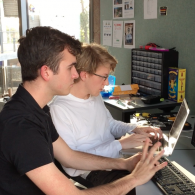Early Progress
Progress is being made! Slowly but surely… We have started to bump into challenges that will take some serious chipping at to overcome, but nothing impossible. In the past few weeks, we have been working on setting up our server that will hold all the data received by the devices. Since our last post, we have set up most of our server side processing, including our SQL database and some image uploading and image processing scripts. For now, we have uploaded some sample data to the server, and we are currently working on pulling that data down from the server and onto the iOS application.
On the hardware side of things, we have gone deeper with the Arduino platform before attempting to switch to ARM. We have gotten the Arduino to periodically upload full-resolution (1200x1600) images to our server, which is exactly what our hardware should do. However, it fails or sends corrupted images occasionally. Since the Arduino is not quite fast enough to do the image processing well, we are looking for another option. Raspberry Pi is one option that is great for a prototype, but not feasible for a final product. A second option is to construct our own board. This past weekend, we went to a class on KiCAD, which is an open source program that enables you to design your own Printed Circuit Board. There, we learned how to design a board and send the design to a manufacturer for printing. We are also trying the ARM platform to see if we can resolve these issues. It is turning out to be quite complicated to use, but so far we have been able to capture and send images to a computer via serial communication, and it has already proven itself more reliable and faster than the Arduino when doing so. Also, we have decided on a design for the device enclosure and have begun modeling it for 3D printing.
Nearly all our projected expenditures have been purchased, with the exception of power and charging equipment for the device, food, and PCB manufacturing. As of yet, $1,531.59 or about 34% of our post-fellowship grant has been spent, leaving $2,968.41. These figures fail to account for the Polo shirts, which should bring the total spending to around 45%, which meets our projected spending for the end of December.
This month, our newly appointed Sustainability Lead began his training on green design, one of the first steps in being certified as a Sustainable Design Associate. In his summary of the initial reading, Brooks had this to say:
“In designing and engineering a product it is crucial that sustainability is considered and implemented. Sustainability defined by the Brundtland commission is as follows: ‘Sustainable development is development that meets the needs of the present without compromising the ability of future generations to meet their own needs.’ A good strategy is to visually sketch a product's life-cycle and mark the requirements for each stage. Different benchmarks exist for measuring the sustainability of a product that include thresholds and overall scores.”
As of now, our invention is relatively sustainable. Not only is our physical design sustainable, but our invention itself is designed to help the environment by monitoring the user’s water usage.
All in all, we are making progress and are on track to present our invention at EurekaFest!


